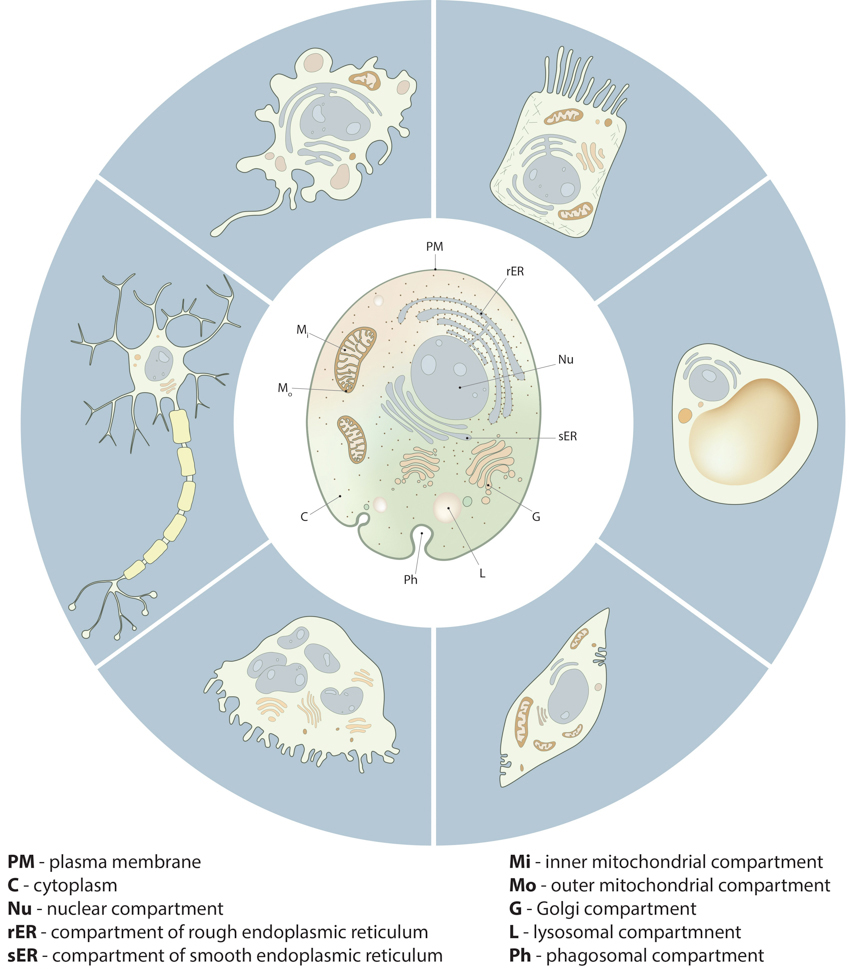Compartmentalization Study Guide
Introduction
Cells are not an amorphous mass of proteins, lipids, and other substances. Instead, all cells are made up of well-defined compartments, each specializing in a certain role. In many circumstances, subcellular activities may be classified depending on whether they occur at the plasma membrane, within membrane-bound organelles, or inside the cytosol, such as golgi apparatus, the nucleus, or even vesicular components of the membrane trafficking system such as endosomes and lysosomes.
Compartmentalization in cells
- By concentrating the necessary components inside a small region within the cell, cell compartmentalization improves the efficiency of several subcellular activities.
- Intracellular membrane systems create enclosed compartments separated from the cytoplasm of the cell.
- When a specific condition is necessary to enable a specific subcellular activity, it may be locally isolated so that it does not interfere with the function of other subcellular compartments.
- Lysosomes, for example, require a lower pH to assist the breakdown of absorbed material. This state is maintained by membrane-bound proton pumps found on the lysosome.
- Similarly, mitochondria requires a wide membrane surface area to synthesize ATP from electron gradients across its lipid bilayer efficiently. This is accomplished via the structural makeup of this specific organelle.
Despite the physical and functional differences between cells from different tissue types and species, all cells have major commonalities in their compartmental structure. The depiction of the general animal cell summarises these key sections, which are commonly referred to as organelles (central cells). Neuron, macrophage, gut epithelial cell, adipocyte, muscle cell, and osteoclast are examples of specialized cell types.
With many proteins and molecular components involved in multiple subcellular processes and thus required throughout multiple subcellular compartments, effective transport of the protein and molecular components, whether by passive diffusion or directed recruitment, is critical for the cell’s overall function.
The significance of compartmentalization
All processes in cells occur in a specific space- a compartment separated from other compartments by semipermeable membranes. They aid in separating even the most chemically diverse settings, allowing the course of chemical processes to be optimized.
Particular enzymes catalyzing individual processes frequently have distinct temperature and pH optimums. If there was just one cellular compartment, a percentage of enzymes would most likely not operate, or the enzyme-catalyzed reactions would be inefficient. The cellular space is divided to generate ideal circumstances for various enzymatically catalyzed processes.
Simultaneously, the cell defends itself against the activities of lytic enzymes. Sealing cellular digestion in lysosomes, for example, avoids inappropriate auto-digestion of other organelles inside the cell. Necrosis and apoptosis activation are two frequent processes that occur when specific compartments are disrupted, such as spilling the contents of lysosomes or mitochondria (the process of programmed cell death).
Compartmentalization impacts metabolic pathway regulation as well, making them more accurate and focused, as well as less conflicting with one another. It is occasionally feasible to control the reaction when a certain substrate enters the compartment (transport across the membrane, often mediated by transport mechanisms).
Despite its benefits, compartmentalization places a larger strain on energy use. It stems from the frequent employment of ATP-dependent transporters, which transport chemicals across membranes against a concentration gradient, resulting in distinct conditions in separate compartments.
Conclusion:
- The cell’s and its organelles’ distinct structure leads to distinct functions.
- According to Christopher VanLang, several physiologically significant roles have evolved around cell compartmentalization. Without cell membranes, there would be no compartmentalization, which is critical for cell operations.
- The cell membrane’s phospholipid accumulation gives it the unusual trait of semi-permeability besides membrane transport proteins.
FAQs:
1. What is an example of compartmentalization in cells?
The nucleus contains the main genome and is the principal site of DNA and RNA synthesis. The cytosol is the site of protein synthesis and degradation.
2. What is required for compartmentalization in a cell?
Eukaryotic cells have membrane-bound organelles and a membrane-bound nucleus, each of which serves a specific role inside the cell. These organelles exist in distinct compartments inside the cell, allowing them to operate in the optimal habitat.
3. How does cell membrane carry out compartmentalization?
Components inside the lipid bilayer split or cluster due to particular interactions and corresponding collective membrane characteristics. Multivalent ions and proteins sequester anionic lipids in the cytosolic membrane leaflet.
4. What is the compartmentalization of cytoplasm?
Cellular compartments in cell biology refer to all closed regions of a eukaryotic cell’s cytoplasm that are normally covered by a single or double lipid layer membrane.
5. What is the importance of compartmentalization in mitochondrial function?
Compartmentalization in mitochondria involves two membranes. The catabolic reactions necessary to form ATP are compartmentalized inside the mitochondrion and separated by the membranes from the cytoplasm. This is because the cytoplasm is the site for anabolic reactions necessary for forming biological macromolecules like carbohydrates, proteins, or phospholipids. By concentrating the necessary components inside a small region within the cell, compartmentalization improves the efficiency of several subcellular activities.
6. What is the significance of intracellular compartmentalization of enzymes?
The cell defends itself against the activities of lytic enzymes by compartmentalization. Sealing cellular digestive enzymes in lysosomes, for example, avoids inappropriate auto-digestion of other organelles inside the cell.
We hope you enjoyed studying this lesson and learned something cool about Compartmentalization! Join our Discord community to get any questions you may have answered and to engage with other students just like you! Don’t forget to download our App to experience our fun, VR classrooms – we promise, it makes studying much more fun! 😎
Sources:
- Compartmentalisation of Metabolic Pathways. http://fblt.cz/en/skripta/ii-premena-latek-a-energie-v-bunce/3-kompartmentace-metabolickych-drah/. Accessed 17 Dec, 2021.
- Interesting Facts about Plant Cells. https://sciencing.com/interesting-plant-cells-5746134.html. Accessed 17 Dec, 2021.
- Compartmentalization in Cells. https://www.mechanobio.info/the-cell/compartmentalization-in-cells-2/. Accessed 17 Dec, 2021.
- The Compartmentalization of Cells. https://www.ncbi.nlm.nih.gov/books/NBK26907/. Accessed 17 Dec, 2021.
- Compartmentalization https://apcentral.collegeboard.org/pdf/ap-biology-course-and-exam-description-0.pdf?course=ap-biology Accessed 17 Dec, 2021.


